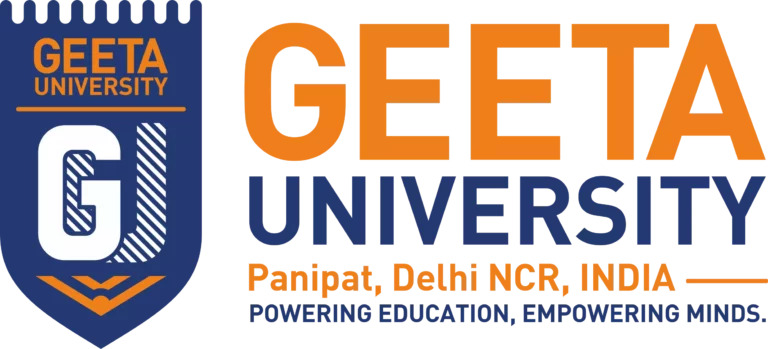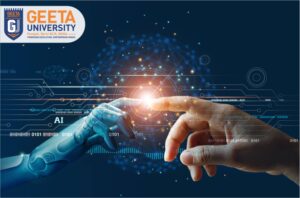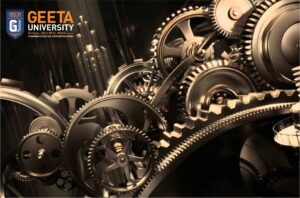AI in Creative Arts & Content Generation – From AI-generated music to deepfake-based movie production.
UncategorizedAI in Creative Arts & Content Generation – From AI-generated music to deepfake-based movie production.
- April 2, 2025
- Geeta University

Artificial Intelligence (AI) is no longer confined to technical and scientific
domains; it is now making waves in the creative arts and content generation.
From composing music and painting masterpieces to producing deepfake-
based movies, AI is redefining the boundaries of creativity. This article
explores how AI is transforming the creative arts, the ethical implications of its
use, and the role of educational institutions like the Best B.Tech. (Hons.)
CSE – Cyber Security college in India in shaping the future of AI-driven
creativity.

Admission Open 2024-2025
For Your bright Future
AI in Music Composition
AI is revolutionizing the music industry by enabling the creation of original
compositions, enhancing production processes, and personalizing listening
experiences.
1. AI-Generated Music:
AI algorithms, such as OpenAI's MuseNet and Google's Magenta, can
compose music in various genres and styles. These systems analyze vast
datasets of existing music to generate original compositions that mimic the
work of famous composers or create entirely new sounds. For example, AI
has been used to compose classical music pieces that are indistinguishable
from those created by human composers.
2. Music Production and Enhancement:
AI tools like LANDR and iZotope use machine learning to automate audio
mastering and mixing, making high-quality music production accessible to
independent artists. AI can also enhance live performances by adjusting
sound levels in real-time and synchronizing visual effects with the music.
3.Personalized Listening Experiences:
Streaming platforms like Spotify and Apple Music use AI to analyze user
preferences and recommend personalized playlists. AI-driven algorithms can
also create dynamic playlists that adapt to the listener's mood and context,
providing a more immersive listening experience.
AI in Visual Arts
AI is making significant strides in visual arts, from generating digital paintings
to restoring historical artworks.
1. AI-Generated Art:
AI algorithms like DeepArt and Runway ML can create digital paintings and
illustrations by analyzing existing artworks. These tools allow artists to
experiment with new styles and techniques, pushing the boundaries of
creativity. For example, the AI-generated portrait "Edmond de Belamy" sold for
$432,500 at Christie's auction house, highlighting the growing acceptance of
AI art.
2. Art Restoration:
AI is being used to restore and preserve historical artworks. By analyzing
high-resolution images of damaged paintings, AI algorithms can reconstruct
missing details and restore the artwork to its original state. This technology is
particularly valuable for preserving cultural heritage.
3. Interactive Art Installations:
AI-powered interactive art installations are becoming increasingly popular in
museums and galleries. These installations use computer vision and natural
language processing to engage with visitors, creating immersive and
personalized experiences.
AI in Film and Video Production
AI is transforming the film and video production industry by automating tasks,
enhancing visual effects, and enabling new forms of storytelling.
1. Deepfake Technology:
Deepfake technology uses AI to create hyper-realistic videos by
superimposing one person's face onto another's body. While this technology
has raised ethical concerns, it also has creative applications, such as
resurrecting deceased actors for movie roles or enabling filmmakers to create
realistic visual effects.
2. Automated Video Editing:
AI-powered video editing tools like Adobe Premiere Pro and Final Cut Pro
use machine learning to automate tasks such as color correction, scene
detection, and audio synchronization. These tools save time and allow
filmmakers to focus on the creative aspects of production.
3. AI-Driven Storytelling:
AI algorithms can analyze scripts and predict audience reactions, helping
filmmakers refine their stories. AI can also generate scripts and storyboards,
enabling new forms of collaborative storytelling. For example, the short film
"Sunspring" was entirely written by an AI algorithm, showcasing the potential
of AI in creative writing.
AI in Literature and Writing
AI is making its mark in literature and writing by assisting authors, generating
content, and enhancing language translation.
1. AI-Assisted Writing:
AI tools like Grammarly and ProWritingAid help writers improve their
grammar, style, and clarity. These tools use natural language processing to
provide real-time feedback, making the writing process more efficient.
2. Content Generation:
AI algorithms can generate articles, blog posts, and even poetry. For
example, OpenAI's GPT-3 can produce coherent and contextually relevant
text based on a given prompt. This technology is particularly useful for content
marketers and journalists who need to produce large volumes of content
quickly.
3. Language Translation:
AI-powered translation tools like Google Translate and DeepL use neural
networks to provide accurate and contextually relevant translations. These
tools are breaking down language barriers and enabling global collaboration in
the creative arts.
Ethical Implications of AI in Creative Arts
While AI offers numerous benefits in the creative arts, it also raises ethical
concerns that need to be addressed.
1. Authorship and Ownership:
The question of who owns the rights to AI-generated content is a complex
issue. Should the creator of the AI algorithm, the user, or the AI itself be
considered the author? This question has significant implications for copyright
law and intellectual property rights.
2. Deepfake Misuse:
Deepfake technology has the potential to be misused for malicious
purposes, such as creating fake news or non-consensual pornography. It is
essential to establish regulations and ethical guidelines to prevent the misuse
of this technology.
3. Bias in AI Algorithms:
AI algorithms are only as good as the data they are trained on. If the training
data is biased, the AI's output may reflect those biases, leading to unfair or
discriminatory outcomes. Ensuring diversity and fairness in AI models is
critical.
4. Impact on Human Creativity:
The increasing use of AI in creative arts raises concerns about the impact
on human creativity. Will AI replace human artists, or will it serve as a tool to
enhance their creativity? Striking a balance between human and machine
creativity is essential.
The Role of Education in Advancing AI in Creative Arts
The rapid advancement of AI in creative arts requires a skilled workforce
capable of developing and implementing AI solutions. Educational institutions
play a crucial role in preparing the next generation of innovators.
One such institution is the Best B.Tech. (Hons.) CSE – Cyber Security
college in India, which offers a comprehensive program in Computer Science
and Engineering with a specialization in Cyber Security. This program equips
students with the knowledge and skills needed to tackle the challenges of AI in
creative arts, including ethical considerations, data privacy, and cybersecurity.
By combining cutting-edge research with practical training, the Best B.Tech.
(Hons.) CSE – Cyber Security college in India is preparing students to
become leaders in the field of AI-driven creativity. Graduates of this program
are well-positioned to contribute to the development of innovative AI solutions
that transform the creative arts and content generation.
Future Prospects of AI in Creative Arts
The future of AI in creative arts is incredibly promising. As AI technologies
continue to evolve, we can expect even greater advancements in music,
visual arts, film, and literature.
1. Collaborative Creativity:
AI will increasingly serve as a collaborative tool for human artists, enabling
new forms of creative expression. For example, musicians can use AI to
generate backing tracks, while visual artists can use AI to experiment with
new styles and techniques.
2. Immersive Experiences:
AI-powered virtual reality (VR) and augmented reality (AR) will create
immersive experiences that blur the line between reality and fiction. These
technologies will revolutionize storytelling, gaming, and interactive art
installations.
3. Personalized Content:
AI will enable the creation of personalized content tailored to individual
preferences and contexts. For example, AI-generated movies could adapt
their plotlines based on the viewer's reactions, providing a unique and
engaging experience.
4. Ethical AI Development:
As AI becomes more integrated into the creative arts, it is essential to
prioritize ethical considerations. Educational institutions like the Best B.Tech.
(Hons.) CSE – Cyber Security college in India will play a crucial role in
fostering ethical AI development and ensuring that these technologies are
used responsibly.
Conclusion
AI is transforming the creative arts and content generation, offering new
possibilities for music, visual arts, film, and literature. While challenges and
ethical concerns remain, the potential benefits of AI in creative arts are
immense. Educational institutions like the Best B.Tech. (Hons.) CSE – Cyber
Security college in India are playing a vital role in preparing the next
generation of AI innovators to address these challenges and drive innovation
in the field.
As AI continues to evolve, it will undoubtedly redefine the boundaries of
creativity, enabling new forms of expression and enhancing the human
experience. By investing in education, research, and ethical considerations,
we can harness the power of AI to create a more vibrant and inclusive creative
landscape.
Expanding the Horizons of AI in Creative Arts
As we delve deeper into the potential of AI in creative arts, it becomes evident
that this technology is not just an incremental improvement but a paradigm
shift in how we approach creativity and content generation. The following
sections explore additional dimensions of AI in creative arts, including its
impact on various sectors, the challenges it faces, and the collaborative efforts
required to realize its full potential.
Impact on Various Sectors
1. Advertising and Marketing:
AI is revolutionizing advertising and marketing by enabling the creation of
personalized and targeted campaigns. AI algorithms can analyze consumer
behavior and preferences to generate content that resonates with specific
audiences. For example, AI-powered tools can create customized video ads,
social media posts, and email campaigns, enhancing engagement and
conversion rates.
2. Gaming and Entertainment:
The gaming industry is leveraging AI to create more immersive and
interactive experiences. AI-driven characters and environments can adapt to
the player's behavior, providing a more personalized and engaging
experience. Additionally, AI can enhance game development by automating
tasks such as level design, character animation, and bug detection.
3. Education and Training:
AI is transforming education and training by enabling the creation of
interactive and personalized learning experiences. AI-powered tools can
generate educational content, such as quizzes, tutorials, and simulations,
tailored to individual learning styles and needs. This technology is particularly
valuable for creative disciplines, such as music, art, and film, where hands-on
practice and feedback are essential.
4. Cultural Preservation:
AI is playing a crucial role in preserving and promoting cultural heritage. AI
algorithms can analyze and digitize historical artifacts, manuscripts, and
artworks, making them accessible to a global audience. Additionally, AI can be
used to restore and preserve cultural landmarks, ensuring that they are
protected for future generations.
Challenges and Collaborative Efforts
1. Interdisciplinary Collaboration:
The development of AI in creative arts requires collaboration across various
disciplines, including computer science, art, music, literature, and ethics.
Institutions like the Best B.Tech. (Hons.) CSE – Cyber Security college in
India are fostering this interdisciplinary approach by offering programs that
integrate these fields, encouraging students to think beyond traditional
boundaries.
2. Ethical and Societal Implications:
As AI becomes more integrated into the creative arts, it is essential to
address the ethical and societal implications of this technology. Issues such
as data privacy, security, and the potential for misuse must be carefully
considered. Educational institutions and policymakers must work together to
establish guidelines and regulations that ensure the responsible development
and deployment of AI in creative arts.
3. Public Awareness and Education:
Raising public awareness about the benefits and challenges of AI in creative
arts is crucial for its widespread adoption. Educational initiatives, workshops,
and seminars can help demystify this technology and encourage more
students to pursue careers in this field. The Best B.Tech. (Hons.) CSE –
Cyber Security college in India is leading the way by offering specialized
courses and research opportunities in AI and creative arts.
Tags
Related Posts

What is Data Security? | Why is Data Security important? | Types of Data Protection – Geeta University
For a variety of reasons, data security is critical for both public and commercial enterprises. First, there is the legal and ethical obligation of companies to protect their user and customer data from falling into the wrong hands. What is

Artificial Intelligence: AI Terms Simply Explained – Geeta University
Unlike humans, AI learns and excels at a limited number of tasks. Weak or thin AI is the name given to such associate AI. They are currently typically superior to humans in their field. Artificial intelligence: AI Terms Simply Explained

Career in Mechanical Engineering – Scope, Courses – Geeta University
Career in Mechanical Engineering- Are you dreaming of making a career in Mechanical Engineering? Do you want this information that how to become Mechanical Engineer. Career in Mechanical Engineering – Scope, Courses Scope of Mechanical Engineering Career in Mechanical Engineering-
